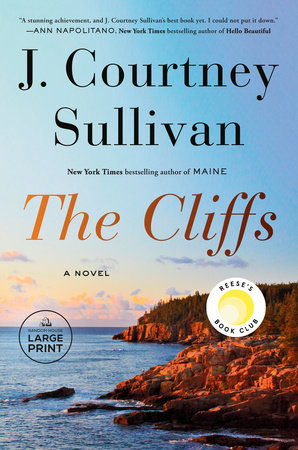READERS GUIDE
IntroductionNovelist J. Courtney Sullivan, the
New York Times bestselling author, now turns her keen eye to family ties that are interwoven with centuries of secret history. In
The Cliffs, a secluded bluff overlooking the Atlantic Ocean has been a place of love and comfort, as well as untold tragedy, for generations. Graced by a once-grand Victorian house, the site captures the attention of teenager Jane Flanagan, who finds a respite there from her turbulent home life. Exploring the corners within the dilapidated lavender walls, Jane tries to imagine who could suddenly abandon so many riches—the beautiful artwork on the walls, the dishes in the cupboard, the piles of
Life magazine beside an unmade bed. And, most mysteriously, a child’s dollhouse, not far from shards of broken glass and splintered wood.
Returning home to Maine twenty years later after building a career as an archivist, Jane is horrified to see that a new owner has gutted the place and erased every trace of the previous family. Well, not every trace . . . the persistent ghost of a little girl is demanding to be heard.
As Jane sets out to research the complete history of the property, she uncovers tales of romantic longing, artistic awakening, and devastating loss, much of it captured in historical artifacts stolen and sold. Raising tantalizing questions about the power of remembrance,
The Cliffs is a tribute to the courageous women who have gone before us—and the long-suppressed histories that are dying to be told. We hope this guide will enhance your reading group’s experience of this deeply moving journey through time.
Questions and Topics for Discussion1.
The Cliffs begins with the limited scope of Jane’s adolescent life. As she recites local history to the passengers on Abe Adams’s lobster boat and navigates the summer program at Bates College, what does she know about the world and her place in it? How does that knowledge change by the end of the novel?
2. Why is Jane drawn to the violet-colored Victorian house? What forms of refuge does it provide to her, despite its dilapidated condition?
3. Discuss Lake Grove’s rumored curse that the women who move there end up alone. What common threads are shared by the husbands, from Captain Littleton and Herbert Martinson to Paul Richards? Is it a curse to end up alone? Which of the house’s inhabitants were the least lonely?
4. What accounts for the differences between Jane and Holly, even though they were raised under the same circumstances? How do their sibling ties compare to Hannah and Agnes’s? And to Eliza and Emily’s?
5. Despite her intense need to be independent, Jane tries repeatedly to save her marriage. In what ways were she and David a good fit for each other and yet a terrible match? In contrast, Jane thrives on her friendship with Allison. What enables their bond to strengthen over the years?
6. What were you predicting for Sister Eliza’s story? How does she serve as a reminder of the voices that remain silent to even the most skilled historical researchers?
7. In chapter 16, Brother Michael tells Jane that the goal of the Shaker faith was utopia, adding, “Imagine what the world could have been had they [the naysayers] listened.” What’s your reaction to that wish?
8. Do you believe that the dead can communicate with the living? Is there any harm done at places like Camp Mira?
9. Discuss the novel’s many different depictions of motherhood and childhood, including Genevieve’s recounting of her own painful girlhood (page 223). Where does Daisy ultimately lead Jane and Genevieve? If you were Marilyn, would you be able to forgive Mary Flanagan?
10. For Mary, her daughter, and her granddaughter, what are the legacies of alcoholism? What factors beyond genetics perpetuate it in their family?
11.
The Cliffs is packed with historical artifacts, from the small Indigenous basket to Staffordshire china, the bonnet, the jar of marbles, and many other tangible pieces of the past. To some, the only value that matters is the financial one. What are the other, nonmonetary reasons to preserve and display such artifacts? What are the most cherished possessions in your own family archive? How much do you know about the final resting places of your ancestors? Which of their stories have survived for generations?
12. In Naomi’s chapter, with scenes of the first people to encounter the cliff and ascribe a sacred purpose to it, what do we learn about the way conquerors use history to perpetuate their power? What does it take for hidden histories—including unmarked burial sites—to be reclaimed and illuminated?
13. J. Courtney Sullivan’s storytelling provides a distinctive perspective on life’s turning points. Which turning points resonated with you the most in
The Cliffs and in her previous novels that you have read?
Suggestions for Further Reading Kate Atkinson,
Shrines of GaietyJo Baker,
The Midnight NewsClare Beams,
The GardenElizabeth Castellano,
Save What’s LeftSandra Cisneros,
CarameloLouise Erdrich,
The Night WatchmanAmity Gaige,
Sea WifeClaire Lombardo,
Same as It Ever WasKimberly McCreight,
Like Mother, Like DaughterElizabeth O’Connor,
Whale FallMaggie O’Farrell,
The Marriage PortraitTommy Orange,
Wandering StarsHelen Oyeyemi
, Boy, Snow, BirdJesmyn Ward
, Sing, Unburied, Sing

